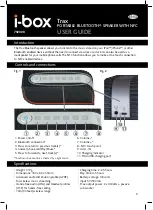
Subwoofer Setup
Begin by determining the best location for your subwoofer. If possible, the optimum set-up
would look like the set-up in Figure 3; however, this setup may not be practical or possible
in your room. Once you have set up your monitors, listen to some program material that
you know contains low frequency information. Different locations may create a phase
misalignment. Most subwoofers have a phase switch on them. Flip the phase switch. The
bass response volume will either increase or decrease in volume. Whichever setting
provides the loudest response at your seating position is in phase. After you have the
proper phase setting, you will need to adjust the output level of the subwoofer to a level that
provides a smooth blend of the bass volume with that of your monitors.
Figure 3
5.1 Channel Surround Sound Setup
Begin by placing the Left and Right front channels 30 degrees from the Center channel and
equidistant to the listening position (Figure 4). The Left Surround (rear) and Right Surround
(rear) channels should be placed 110 degrees from the Center channel. Their location
should also be equidistant from the listening position. The subwoofer (Low Frequency
Effects) channel is most effective when situated directly below the Center channel
(as shown in Figure 4). If this is not possible, place the subwoofer just to the right or left
side and below the Center channel. Ensure that the woofers are above the height of the
console.
Once the monitors have been placed, you’ll need to adjust the System Level Adjust pots
for each monitor so that all channels have exactly the same SPL output at the listening
position. Although this can be done simply by listening to each channel one at a time and
adjusting for relative levels, we recommend using an SPL meter and filtered noise (pink
noise) to test each channel independently. Simply take a reading from each monitor, and
then adjust all the monitors to match your lowest SPL reading. Your system levels should
now be balanced for multi-channel surround.
The most significant point to remember is that each room presents its own set of acoustic
variables. You'll want to experiment to arrive at the best possible sound for your room.
10
Summary of Contents for Expose E8
Page 1: ...U S E R G U I D E E X P O S É E 8 B B I A M P L I F I E D S T U D I O M O N I T O R ...
Page 2: ...2 ...
Page 16: ......


































